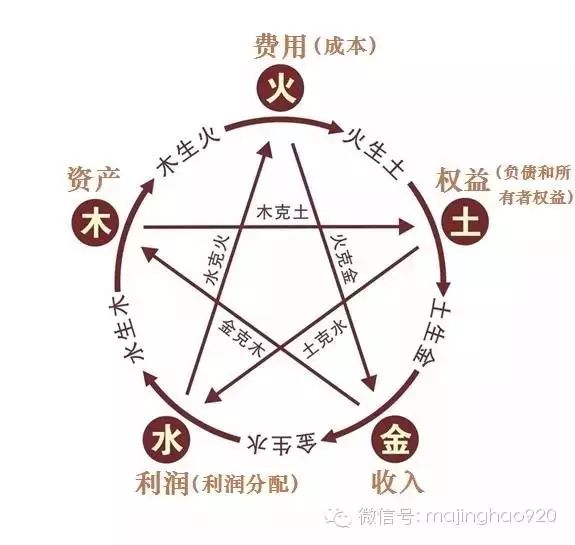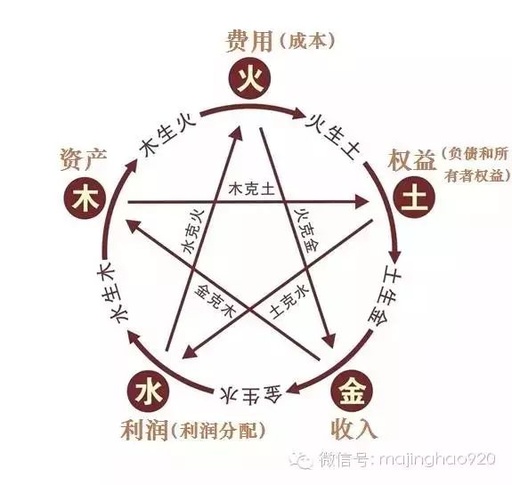Editor’s Note: This article was published by the author in August two years ago in the “Finance and Accounting News”. It combines accounting with the Five Elements, demonstrating a connection that proves the principle of interrelatedness in all things. Confucius, at fifty, studied the “I Ching” and was astounded, making numerous annotations and understanding the laws of development in all things. The author plans to connect financial analysis with the 64 hexagrams of the “I Ching”, creating a unique perspective……
When it comes to the Five Elements, many people think of the “I Ching”. In fact, the well-known principles of the Five Elements originate from this text. The “I Ching” posits that all things in the world are composed of five elements: Metal, Wood, Water, Fire, and Earth, which interact with each other in cycles of generation and overcoming. The “Five Element Theory” is an ancient Chinese theory that integrates philosophy, science (physics, chemistry, biology, etc.), sociology, and more. The “Five Elements” correspond to the five organs of the human body, the five musical notes, and the five energies of nature. While studying the “I Ching”, the author has been contemplating whether there are “Five Elements” in accounting and the corresponding relationships of generation and overcoming.
We know that “the generation of the Five Elements” refers to: Metal generates Water, Water generates Wood, Wood generates Fire, Fire generates Earth, and Earth generates Metal; “the overcoming of the Five Elements” refers to: Metal overcomes Wood, Wood overcomes Earth, Earth overcomes Water, Water overcomes Fire, and Fire overcomes Metal. The author believes that there are also generative and overcoming relationships among the Five Elements in the field of accounting, corresponding to accounting elements. Here, Wood corresponds to assets, Earth corresponds to equity (including liabilities and owner’s equity), Metal corresponds to income, Fire corresponds to expenses (costs), and Water corresponds to profit (profit distribution). The accounting elements of assets, equity (including liabilities and owner’s equity), income, expenses (costs), and profit (profit distribution) also have relationships of generation and overcoming.
Therefore, according to the traditional “Five Element Theory”, the generative relationships in accounting are: Income generates Profit, Profit generates Assets, Assets generate Expenses (costs), Expenses (costs) generate Equity (liabilities and owner’s equity), and Equity (liabilities and owner’s equity) generates Income. The overcoming relationships in accounting are: Income overcomes Assets, Assets overcome Equity (liabilities and owner’s equity), Equity (liabilities and owner’s equity) overcomes Profit, Profit overcomes Expenses (costs), and Expenses (costs) overcome Income.

The above image is the “Five Elements in Accounting” diagram created by the author.
Let’s first look at the generative relationships in accounting: (1) Metal generates Water. In accounting, Metal represents income. The more income there is, the more profit (profit distribution) there will be. This aligns with the logic that Metal (income) generates Water (profit, including profit distribution). (2) Water generates Wood. In accounting, Water represents profit (profit distribution). As profit increases, assets will naturally increase. This aligns with the logic that Water (profit, including profit distribution) generates Wood (assets). (3) Wood generates Fire. In accounting, Wood represents assets. Having assets provides the basis for spending. The consumption of assets is expenses (including costs). This aligns with the logic that Wood (assets) generates Fire (expenses, including costs). (4) Fire generates Earth. In accounting, Fire represents expenses (including costs). If spending is high and expenses are not controlled, it will inevitably lead to an increase in liabilities or capital investment. This aligns with the logic that Fire (expenses, including costs) generates Earth (equity, including liabilities and owner’s equity). (5) Earth generates Metal. In accounting, Earth represents equity (including liabilities and owner’s equity). Having money makes things easier; the more loans a business takes from banks and the more investors invest, the more capable the business is to continuously expand production and increase income. This aligns with the logic that Earth (equity) generates Metal (income).
Next, let’s examine the overcoming relationships in accounting: (1) Metal overcomes Wood, which in accounting means income overcomes assets. This may seem difficult to understand at first, but income does indeed overcome assets; to obtain more income, one must sell more inventory and consume more fixed assets, etc. (2) Wood overcomes Earth, which in accounting means assets overcome equity (including liabilities and owner’s equity). This can be understood from the accounting dynamic balance equation “Income – Expenses = Assets – Liabilities – Owner’s Equity”. The purpose of business operations is to generate profit, to preserve and increase the value of assets. The result of Wood (assets) overcoming Earth (equity, including liabilities and owner’s equity) is the business performance created and the increase in net assets. If assets are less than equity, or if liabilities exceed assets, the business will incur losses, and net assets will decrease. (3) Earth overcomes Water, which in accounting means equity (liabilities and owner’s equity) overcomes profit (including profit distribution). One can see that in the current difficult business environment, companies lacking funds must borrow from banks or take high-interest loans, resulting in most profits being transferred to banks or loan sharks. Working for banks has become a reality in the current business world. (4) Water overcomes Fire, which in accounting means profit overcomes expenses (including costs). To increase profit, one must cut costs, which means reducing expenditures. (5) Fire overcomes Metal, which in accounting means expenses (including costs) overcome income. This is easy to understand; the more expenses there are, the less income there will be.
This is the “Five Elements in Accounting” theory that the author has derived from studying the “I Ching”. The author believes that the laws of all things can be understood through the “Five Elements”, and naturally, the laws of accounting can also be understood. Everything in existence is based on the principle of “Yin and Yang”. The double-entry bookkeeping in accounting actually reflects the Yin-Yang theory in the “I Ching”. The “I Ching” states: “The I Ching has the Supreme Ultimate, which produces the Two Forms”, where the “Two Forms” refers to “Yin and Yang”, which corresponds to the “debit and credit” in accounting.

